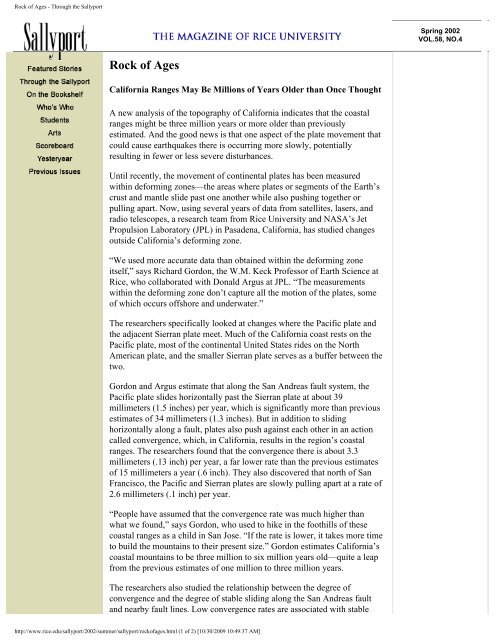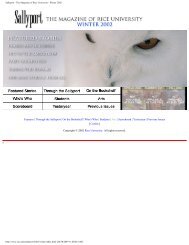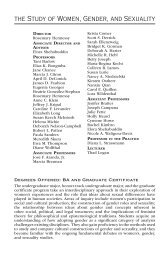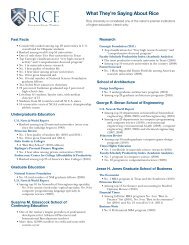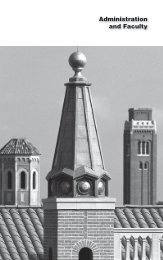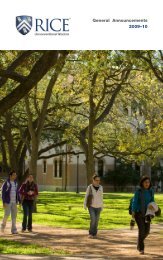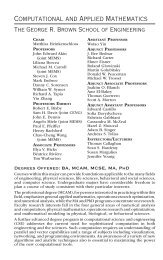Sallyport - The Magazine of Rice University - Summer 2002
Sallyport - The Magazine of Rice University - Summer 2002
Sallyport - The Magazine of Rice University - Summer 2002
Create successful ePaper yourself
Turn your PDF publications into a flip-book with our unique Google optimized e-Paper software.
Rock <strong>of</strong> Ages - Through the <strong>Sallyport</strong><br />
Spring <strong>2002</strong><br />
VOL.58, NO.4<br />
Rock <strong>of</strong> Ages<br />
California Ranges May Be Millions <strong>of</strong> Years Older than Once Thought<br />
A new analysis <strong>of</strong> the topography <strong>of</strong> California indicates that the coastal<br />
ranges might be three million years or more older than previously<br />
estimated. And the good news is that one aspect <strong>of</strong> the plate movement that<br />
could cause earthquakes there is occurring more slowly, potentially<br />
resulting in fewer or less severe disturbances.<br />
Until recently, the movement <strong>of</strong> continental plates has been measured<br />
within deforming zones—the areas where plates or segments <strong>of</strong> the Earth’s<br />
crust and mantle slide past one another while also pushing together or<br />
pulling apart. Now, using several years <strong>of</strong> data from satellites, lasers, and<br />
radio telescopes, a research team from <strong>Rice</strong> <strong>University</strong> and NASA’s Jet<br />
Propulsion Laboratory (JPL) in Pasadena, California, has studied changes<br />
outside California’s deforming zone.<br />
“We used more accurate data than obtained within the deforming zone<br />
itself,” says Richard Gordon, the W.M. Keck Pr<strong>of</strong>essor <strong>of</strong> Earth Science at<br />
<strong>Rice</strong>, who collaborated with Donald Argus at JPL. “<strong>The</strong> measurements<br />
within the deforming zone don’t capture all the motion <strong>of</strong> the plates, some<br />
<strong>of</strong> which occurs <strong>of</strong>fshore and underwater.”<br />
<strong>The</strong> researchers specifically looked at changes where the Pacific plate and<br />
the adjacent Sierran plate meet. Much <strong>of</strong> the California coast rests on the<br />
Pacific plate, most <strong>of</strong> the continental United States rides on the North<br />
American plate, and the smaller Sierran plate serves as a buffer between the<br />
two.<br />
Gordon and Argus estimate that along the San Andreas fault system, the<br />
Pacific plate slides horizontally past the Sierran plate at about 39<br />
millimeters (1.5 inches) per year, which is significantly more than previous<br />
estimates <strong>of</strong> 34 millimeters (1.3 inches). But in addition to sliding<br />
horizontally along a fault, plates also push against each other in an action<br />
called convergence, which, in California, results in the region’s coastal<br />
ranges. <strong>The</strong> researchers found that the convergence there is about 3.3<br />
millimeters (.13 inch) per year, a far lower rate than the previous estimates<br />
<strong>of</strong> 15 millimeters a year (.6 inch). <strong>The</strong>y also discovered that north <strong>of</strong> San<br />
Francisco, the Pacific and Sierran plates are slowly pulling apart at a rate <strong>of</strong><br />
2.6 millimeters (.1 inch) per year.<br />
“People have assumed that the convergence rate was much higher than<br />
what we found,” says Gordon, who used to hike in the foothills <strong>of</strong> these<br />
coastal ranges as a child in San Jose. “If the rate is lower, it takes more time<br />
to build the mountains to their present size.” Gordon estimates California’s<br />
coastal mountains to be three million to six million years old—quite a leap<br />
from the previous estimates <strong>of</strong> one million to three million years.<br />
<strong>The</strong> researchers also studied the relationship between the degree <strong>of</strong><br />
convergence and the degree <strong>of</strong> stable sliding along the San Andreas fault<br />
and nearby fault lines. Low convergence rates are associated with stable<br />
http://www.rice.edu/sallyport/<strong>2002</strong>/summer/sallyport/rock<strong>of</strong>ages.html (1 <strong>of</strong> 2) [10/30/2009 10:49:37 AM]


